Prof . Lidwien Kapteijns
Introduction
When large-scale violence occurs in Africa, initial analyses rarely go beyond characterizations of it (and, by implication, characterizations of the nature of the groups involved) as “ethnic” or “tribal.” Over time, more nuanced, historically based, and carefully contextualized analyses emerge.
 These often try to understand the complexities of, and changes in the nature of, the groups and group identities in whose name violence has been committed and suffered. Thus, in the scholarship about Rwanda, for example, conceptualizations of the labels/identity constructs of “Hutu”and “Tutsi” have become quite sophisticated, even as the classification of the violence as genocide has (justifiably) remained uncontested (Eltringham 2004; Newbury 1998). In the case of Darfur, more carefully historicized and contextualized understandings of the labels “Arab” and “Black” or “African” are emerging as we speak, and here the categorization of the violence as genocide is hotly contested and the interests of advocates of this naming are critically examined (Willemse 2005 and 2009; Mamdani 2009). However, in the case of Somalia, there has been little in-depth scholarly analysis of the violence that accompanied state collapse; as a result, the nature of the groups involved as perpetrators or victims—in this context referred to as “clans”—is too often taken at face value.
These often try to understand the complexities of, and changes in the nature of, the groups and group identities in whose name violence has been committed and suffered. Thus, in the scholarship about Rwanda, for example, conceptualizations of the labels/identity constructs of “Hutu”and “Tutsi” have become quite sophisticated, even as the classification of the violence as genocide has (justifiably) remained uncontested (Eltringham 2004; Newbury 1998). In the case of Darfur, more carefully historicized and contextualized understandings of the labels “Arab” and “Black” or “African” are emerging as we speak, and here the categorization of the violence as genocide is hotly contested and the interests of advocates of this naming are critically examined (Willemse 2005 and 2009; Mamdani 2009). However, in the case of Somalia, there has been little in-depth scholarly analysis of the violence that accompanied state collapse; as a result, the nature of the groups involved as perpetrators or victims—in this context referred to as “clans”—is too often taken at face value.
When it comes to thinking about “clan,” the field of Somali studies has been characterized by two paradigms, both of which will be discussed below. The first paradigm emphasizes clanship and “clan” (that is to say, the notion of agnation or patrilineal descent that constructs the groups called lineage, clan, and clan family) as the basic social institution and the major and enduring principle of the sociopolitical organization of Somali society. From its perspective, the principle of “clan” structures the overall system, in whose functioning it has always been and remains the major determinant. For example, according to this paradigm, Somalis may today have replaced their spears with bazookas and rocket-propelled grenades, but the basic structure of their sociopolitical system and the function of clan in it have remained the same. I. M. Lewis developed this theoretical model in the late 1950s, as he updated the structural functionalist approaches to social anthropology of Radcliffe-Brown and alinowski by letting go of static structuralism but holding on to a modified notion of “function” (Lewis 1968, xxiv, and 1999a, 23).2 As this modified structural-functionalist approach appears to have mostly survived in Somali studies, where I. M. Lewis half a century later is still defending it, I will call it the Lewisian paradigm.
The second paradigm holds that the Lewisian perspective over emphasizes the importance of “clan” and that this overemphasis emerged in a very specific historical context, namely, that of the late-colonial consensus between British rulers and Somali subjects recorded by Lewis during his 1955–57 fieldwork. According to this second theoretical model, clanship is therefore not a basic and stable organizational and behavioral principle of Somali society but a basic principle of a particular and extremely influential way of thinking about Somali society, a way of thinking—a discourse if you will—with a very particular history and a nefarious influence in the present. As this paradigm sets out to “deconstruct” clanship as a natural, self-evident category, I will call it “deconstructive” and historical, terms to be further discussed below.3 I will briefly lay out three arguments that may help to disprove and displace the Lewisian paradigm: first, that clanship was never the only important organizational principle of Somali social organization in the past; second, that clanship is not static, given, or self-evident but acquires its meaning as it “is performed” in specific contexts; and third, that the Lewisian paradigm with its overemphasis on clanship not only has a history of which it is unaware but, because of that history, has alsocontributed to the clan discourse that continues to dominate thinking about Somalia today. This essay will review each argument in turn and then draw some provocative conclusions.
Lidwien Kapteijns
Wellesley College,
Wellesley, MA
Wellesley College,
Wellesley, MA
No comments:
Post a Comment